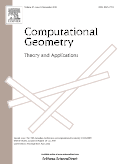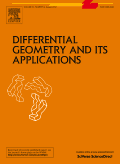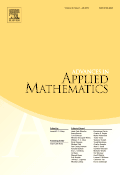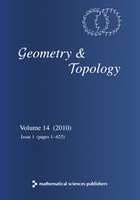
COMPUTATIONAL GEOMETRY-THEORY AND APPLICATIONS
Scope & Guideline
Charting New Territories in Computational Geometry Research
Introduction
Aims and Scopes
- Geometric Algorithms:
Development and analysis of algorithms for solving geometric problems, including computational efficiency and theoretical foundations. - Geometric Structures:
Study of the properties and characteristics of various geometric structures such as polygons, polyhedra, and graphs. - Optimization Problems:
Exploration of optimization problems within geometric contexts, focusing on efficiency and effectiveness in computational solutions. - Graph Theory Applications:
Application of geometric principles to graph theory, including routing, connectivity, and geometric representations. - Topological and Combinatorial Geometry:
Investigating the relationships between topology, combinatorial structures, and geometric configurations. - Robotics and Motion Planning:
Addressing challenges in robotic movement and planning through geometric modeling and algorithms. - Data Structures for Geometric Queries:
Design and analysis of data structures to efficiently handle queries related to geometric data.
Trending and Emerging
- Dynamic and Online Algorithms:
There is a growing focus on algorithms that handle dynamic data and online scenarios, reflecting the needs of real-time applications. - Algorithmic Applications in Robotics:
Emerging themes in robotic motion planning and geometric modeling are gaining attention, highlighting the intersection of computation and robotics. - Geometric Data Structures for Big Data:
Research into efficient data structures for handling large geometric datasets is on the rise, driven by advancements in data science and analytics. - Topological Data Analysis:
Increasing interest in applying topological concepts to geometric problems, particularly in analyzing shapes and structures from data. - Geometric Machine Learning:
The incorporation of machine learning techniques into geometric problems is becoming prominent, reflecting the interdisciplinary nature of current research.
Declining or Waning
- Static Geometric Problems:
Research focusing on static geometric problems has decreased, possibly due to the increasing interest in dynamic and online algorithms. - Classical Geometric Constructions:
The emphasis on classical constructions and theoretical proofs has waned in favor of more applied and computational aspects of geometry. - Low-Dimensional Geometry:
There appears to be a reduced focus on low-dimensional geometric problems as researchers explore higher-dimensional applications and complexities. - Basic Geometric Properties:
Basic studies of geometric properties without computational implications are less frequent, as the journal shifts towards more complex and applicable geometric theories.
Similar Journals

Journal of Geometry
Connecting Mathematicians through Geometric InnovationJournal of Geometry, published by SPRINGER BASEL AG, is a prominent scholarly journal, ISSN 0047-2468 and E-ISSN 1420-8997, dedicated to the field of Geometry and Topology. Hailing from Switzerland, this journal has been a vital resource for researchers since its inception in 1971 and continues to contribute invaluable insights into geometric theories and applications through 2024. With a HIndex that reflects its academic impact, the journal currently ranks in the Q3 category for Geometry and Topology, placing it within the top half of publications in its field, as evidenced by its Scopus ranking of #71 out of 106 in Mathematics, Geometry, and Topology. The Journal of Geometry serves as a platform for original research, reviews, and special issues that address foundational and cutting-edge topics, making it an essential read for mathematicians, educators, and students alike. While it is not an open-access publication, the journal maintains accessibility through institutional subscriptions, ensuring that its significant contributions to geometry are readily available to the academic community.

ARS Mathematica Contemporanea
Pioneering Insights in Contemporary MathematicsARS Mathematica Contemporanea, published by UP FAMNIT in Slovenia, stands as a pivotal journal within the fields of algebra, number theory, discrete mathematics, geometric topology, and theoretical computer science. Since its inception in 2011, this journal has consistently provided a rich platform for innovative research, garnering a commendable Q2 category ranking in various mathematical domains, including Algebra and Number Theory, and Geometry and Topology, showcasing its growing influence and prestige in the academic community. With an increasing Scopus rank—particularly notable in Algebra and Number Theory at the 71st percentile—ARS Mathematica Contemporanea is dedicated to publishing high-quality, peer-reviewed content that advances the frontiers of mathematical knowledge. The journal’s commitment to open access ensures that valuable research is readily available to scholars, practitioners, and students alike, fostering collaboration and dissemination of ideas across the globe. As it converges towards its dedicated timeline extending to 2024, ARS Mathematica Contemporanea remains a crucial resource for those engaged in mathematical research, presenting an array of theoretical and practical insights that define contemporary mathematical discourse.

Acta Mathematica Universitatis Comenianae
Connecting scholars through groundbreaking mathematical research.Acta Mathematica Universitatis Comenianae is a distinguished journal dedicated to advancing the field of mathematics, particularly in its miscellaneous branches. Published by Comenius University in Slovakia, this journal provides a vital platform for researchers and scholars to disseminate their findings and engage with contemporary mathematical discourse. Despite being categorized in the fourth quartile for 2023 in general mathematics within Scopus, the journal plays an essential role in fostering academic dialogue and contributing to regional developments in mathematical research. The journal's scope includes a wide array of topics, ensuring contributions from various domains of mathematics are encouraged. With its commitment to publishing quality research, Acta Mathematica Universitatis Comenianae is an invaluable resource for professionals, students, and academics seeking to expand their knowledge and engage with a community of its peers.

GEOMETRIAE DEDICATA
Bridging Theory and Practice in Geometric StudiesGEOMETRIAE DEDICATA is a distinguished journal published by Springer, focusing on the intricate and dynamic field of geometry and topology. With an ISSN of 0046-5755 and an E-ISSN of 1572-9168, this journal has been a vital resource since its inception in 1972, continuing to provide insightful research up until 2024. Recognized for its scholarly contributions, it holds a Q3 category ranking in the field as of 2023, showcasing its commitment to advancing theoretical and applied geometrical investigations. Located in the Netherlands, specifically at VAN GODEWIJCKSTRAAT 30, 3311 GZ DORDRECHT, the journal offers its audience a platform to explore various aspects of geometry, encouraging interdisciplinary collaboration and knowledge dissemination. Although currently not an open-access journal, it is widely cited and respected in the academic community, making it an essential publication for researchers, students, and professionals devoted to expanding the boundaries of geometric science.

DIFFERENTIAL GEOMETRY AND ITS APPLICATIONS
Innovating Through Differential Geometry ResearchDIFFERENTIAL GEOMETRY AND ITS APPLICATIONS, published by Elsevier, is a premier academic journal primarily focused on the intricacies of differential geometry and its wide-ranging applications in various fields, including mathematics and theoretical physics. Established in 1991 and currently exploring relevant advancements through 2024, this journal serves as a vital platform for disseminating high-quality research that integrates theory and computational methodologies.With an ISSN of 0926-2245 and an E-ISSN of 1872-6984, it holds a significant position within the mathematical community, evidenced by its current quartile ranking of Q3 in major categories such as Analysis, Computational Theory and Mathematics, and Geometry and Topology. While open access options are not available, the journal's contributions are pivotal for researchers seeking to enrich their understanding of complex geometrical frameworks and their practical applications. As the landscape of differential geometry evolves, this journal stands out as a crucial resource for fostering innovation and collaboration among scholars and practitioners alike.

ADVANCES IN APPLIED MATHEMATICS
Empowering Real-World Solutions Through MathematicsADVANCES IN APPLIED MATHEMATICS, published by ACADEMIC PRESS INC ELSEVIER SCIENCE, is a prestigious journal that has served the mathematical community since 1980. With its ISSN 0196-8858 and E-ISSN 1090-2074, the journal is based in the United States, specifically in San Diego, CA. As a leading periodical in the field, it holds a notable Q2 ranking in Applied Mathematics and has been consistently ranked in the 43rd percentile among similar journals, illustrating its relevance and impact within the discipline. Although not an Open Access journal, ADVANCES IN APPLIED MATHEMATICS plays a crucial role in disseminating significant research findings, theoretical studies, and innovative applications of mathematics that address real-world problems. Researchers, professionals, and students alike will find valuable insights in its carefully curated publications, making it an essential resource for those looking to advance their understanding and application of mathematics.

GEOMETRY & TOPOLOGY
Where Geometry Meets Topology: Discover New DimensionsGeometry & Topology is a leading journal in the field of mathematics, focusing on the intricate relationships between geometric structures and topological spaces. Published by Geometry & Topology Publications in the United Kingdom, this prestigious journal boasts an impressive ranking, placing it in the Q1 quartile for Geometry and Topology as of 2023, with a notable Scopus rank of #13 out of 106, indicating its significant impact within the discipline (88th percentile). With publication years spanning from 1997 to 2024, the journal serves as a vital platform for disseminating high-quality research, fostering advances in both theoretical and applied aspects of the field. While it does not currently operate under an Open Access model, it nevertheless attracts the attention of a diverse audience, including researchers, academics, and students eager to explore innovative methodologies and findings in geometry and topology. The journal’s commitment to excellence makes it an essential resource for anyone passionate about mathematical research.

Journal of Computational Geometry
Connecting Theory and Application in GeometryThe Journal of Computational Geometry, published by the Carleton University Department of Mathematics & Statistics, is a premier open-access journal dedicated to advancing the field of computational geometry. With an ISSN of 1920-180X, this journal has been a vital resource since its inception, promoting robust research since 2010. Situated in Canada, it provides a platform for high-quality papers that explore algorithms and computational techniques related to geometric structures and their applications.
Though currently classified in Q3 category quartiles across several domains—including Computational Theory and Mathematics, Computer Science Applications, and Geometry and Topology—its commitment to fostering innovation and collaboration within the mathematical community makes it a noteworthy contender for academic contributions. Researchers, professionals, and students interested in the intersection of computational methodologies and geometric analysis can find valuable insights and emerging trends within its pages. As of 2023, the journal's Scopus rankings reflect a growing interest, providing fruitful avenues for interdisciplinary research opportunities and scholarly communication in this dynamic and evolving field.

JOURNAL OF GEOMETRIC ANALYSIS
Advancing the Frontiers of Geometric InsightJOURNAL OF GEOMETRIC ANALYSIS, published by SPRINGER, stands as a premier platform for the dissemination of high-quality research in the field of geometric analysis. With its ISSN 1050-6926 and E-ISSN 1559-002X, this prestigious journal has maintained a robust academic reputation since its inception in 1991, boasting a convergence of ideas and research that will continue through 2024. It is categorized in the top quartile (Q1) of Geometry and Topology, highlighting its significance and influence in the mathematical community. Ranking 23rd out of 106 in its field, and placing in the 78th percentile according to Scopus metrics, this publication is essential for researchers, professionals, and students who seek to deepen their understanding of geometric structures and their applications. Though it operates under a subscription model rather than Open Access, the journal consistently aims to advance knowledge through rigorous peer-reviewed articles that explore the latest developments and methodologies in geometric analysis, making it a pivotal resource for anyone involved in mathematical research.

DISCRETE MATHEMATICS
Illuminating the path for future mathematical innovations.DISCRETE MATHEMATICS, published by Elsevier, is a leading journal dedicated to the field of discrete mathematics and combinatorics, with a distinguished presence in the academic community since its inception in 1971. With an ISSN of 0012-365X and an E-ISSN of 1872-681X, this esteemed journal has firmly established itself within the Q1 category for Discrete Mathematics and Combinatorics, and Q2 for Theoretical Computer Science as per the 2023 metrics, underscoring its pivotal role in advancing research in these vital areas. DISCRETE MATHEMATICS is highly regarded, reflected in its Scopus rankings, where it stands at #44 out of 92 in its primary category, contributing significantly to the global discourse on complex mathematical theories and applications. Published from the Netherlands, the journal serves as a crucial resource for researchers, professionals, and students looking to stay informed about the latest innovations and methodologies in discrete mathematics. Though currently not an open-access journal, DISCRETE MATHEMATICS continues to foster a vibrant scholarly community through rigorous peer-reviewed research, promoting a deeper understanding of the mathematical structures that underpin both theoretical and applied science.